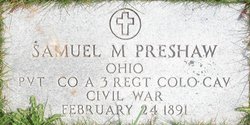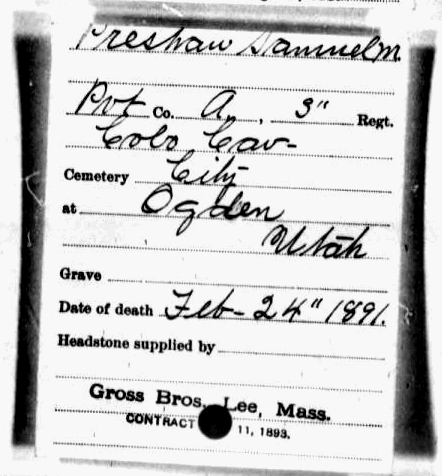Samuel's first marriage was to Anna A. Slaughter. She was the daughter of John Slaughter, a long-serving police justice in Cheyenne and State of WY Librarian. They had a least 4 children.
It is uncertain what happened to Anna (aka Amelia) after the 1880 census. There is a suggestion she returned to her native Athens, OH and was residing there as a widow in 1910.
Samuel may have been married 3 times. His last wife was Nellie C.
His older brother, John M. Preshaw , a Captain and Chaplain during the civil war, is also buried with a military headstone in the Aultorest Memorial Park of Ogden, Utah.
In 1860, at the age of 30 years, Samuel emigrated from Ohio to Mountain City, Arapahoe County, Kansas Territory--present day Denver, Colorado.
He enlisted for 100 days as a private in Co A, 3rd Regiment, Colorado Cavalry during the Civil War. This regiment had been formed by the territorial governor to address disruption to immigrant trails by Indians. Some of the companies of this regiment participated in the notorious Sand Creek Massacre in November 29, 1864. It is not known whether Samuel's company directly participated in the massacre.
By August, 1867, Samuel was a participant in the committee which chartered Cheyenne, Dakota Territory. This was before the arrival of the transcontinental railroad. After the charter, he served as town alderman. He also served as the 3rd and last sheriff of Cheyenne Dakota Territory.
In early Cheyenne, Samuel was a principle organizer of the local "Grant Club" whose mission it was to elect Lieut. Gen. U. S. Grant president of the United States.
By trade, Samuel was a carpenter and building contractor. He built many of the buildings on 17th street in early Cheyenne. Later, after removal to Utah, he continued as a building contractor, erecting buildings there and in western Wyoming.
In 1878, Samuel was appointed superintendent of the construction of the government's buildings at Wounded Knee on the Pine Ridge Indian Reservation.
Besides building cnstruction, Samuel was also made cabinetry; including coffins. For a while, he was an undertaker. He also partnered in a wholesale business selling corn, oats, pork, bacon, "etc."
Samuel's ads as a carpenter and building contractor are nearly in every edition of early Cheyenne newspapers.
SAMUEL PRESHAW SHOULD BE REMEMBERED AS AN INTEGRAL "FOUNDING FATHER" OF CHEYENNE, WYOMING.
Samuel's first marriage was to Anna A. Slaughter. She was the daughter of John Slaughter, a long-serving police justice in Cheyenne and State of WY Librarian. They had a least 4 children.
It is uncertain what happened to Anna (aka Amelia) after the 1880 census. There is a suggestion she returned to her native Athens, OH and was residing there as a widow in 1910.
Samuel may have been married 3 times. His last wife was Nellie C.
His older brother, John M. Preshaw , a Captain and Chaplain during the civil war, is also buried with a military headstone in the Aultorest Memorial Park of Ogden, Utah.
In 1860, at the age of 30 years, Samuel emigrated from Ohio to Mountain City, Arapahoe County, Kansas Territory--present day Denver, Colorado.
He enlisted for 100 days as a private in Co A, 3rd Regiment, Colorado Cavalry during the Civil War. This regiment had been formed by the territorial governor to address disruption to immigrant trails by Indians. Some of the companies of this regiment participated in the notorious Sand Creek Massacre in November 29, 1864. It is not known whether Samuel's company directly participated in the massacre.
By August, 1867, Samuel was a participant in the committee which chartered Cheyenne, Dakota Territory. This was before the arrival of the transcontinental railroad. After the charter, he served as town alderman. He also served as the 3rd and last sheriff of Cheyenne Dakota Territory.
In early Cheyenne, Samuel was a principle organizer of the local "Grant Club" whose mission it was to elect Lieut. Gen. U. S. Grant president of the United States.
By trade, Samuel was a carpenter and building contractor. He built many of the buildings on 17th street in early Cheyenne. Later, after removal to Utah, he continued as a building contractor, erecting buildings there and in western Wyoming.
In 1878, Samuel was appointed superintendent of the construction of the government's buildings at Wounded Knee on the Pine Ridge Indian Reservation.
Besides building cnstruction, Samuel was also made cabinetry; including coffins. For a while, he was an undertaker. He also partnered in a wholesale business selling corn, oats, pork, bacon, "etc."
Samuel's ads as a carpenter and building contractor are nearly in every edition of early Cheyenne newspapers.
SAMUEL PRESHAW SHOULD BE REMEMBERED AS AN INTEGRAL "FOUNDING FATHER" OF CHEYENNE, WYOMING.
Inscription
Pvt, Co A, 3rd Regiment, Colorado Cavalry.
Advertisement
Advertisement








